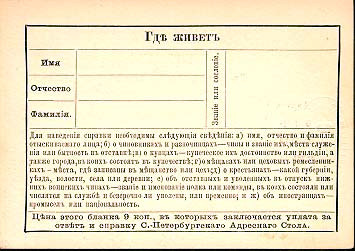Reverse of Address Bureau card
The reverse of the card is divided into distinct areas:
- The top line says "where he/she lives"
- Immediately below that is the area in which you enter the name of the person for whom you are looking--top left three boxes top to bottom
- To the right of the name area is an area in which you indicate the rank or any aditional information about the social category of the individual for whom you are looking (top right box) according to the details below
- Detail (description) area in the middle indicating the various social categories from which you can choose to determine the information required for the additional information box
- Two-line area at the bottom with info about price of the card.
The left three fill-in boxes, top to bottom contain respectively:
- Name (First Name)
- Patronymic (Father's Name with a suffix depending on the person's sex)
- Surname (Last Name)
The detail (description) area states what information should be provided in the additional information box (upper right) in order to get the requested address. It contains 7 (seven) items numbered with Cyrillic characters (a-zh). Click here to see enlarged image of this area.
The first item states again that for all addresses the seeker must supply Name, Patronymic, and Surname of the person about whom he/she is inquiring.
The following 6 (six) items list social categories of citizens and required additional information about each that should be supplied by the seeker: this info was supposed to be put into the upper right free-form fill-in box. This is not a complete TABLE OF RANKS of Imperial Russia, but it is a good abbreviated substitute for it. Below are translations of each item numbered from 1 to 6.
Based on the above descriptions we can make an attempt to reconstruct how the information was stored and organized (every sentence in the next paragraph should be read with a "MOST LIKELY" prefix).
Only the lower social categories required additional information to be provided - no gentry, higher military personnel, or other higher classes are listed. Information about all those "unlisted" categories was stored in a separate box (room, bookcase, etc.). It was enough to state their name, patronymic and surname. No additional information in the right fill-in box was required. On the other hand, information about each of the "listed" lower social categories was stored separately and organized differently - we, in our computer age, would say that it was sorted by different indices. For example, information about peasants was organized by the gubernias from which they came, and within gubernias by district and so on.
It would be an interesting and challenging research project to find out if address information about each social category was provided by different clerks, in other words if they were "specialized." Collectors with many of these cards in their collections should be able to do it.
Thus, this little utility card gave us a chance to look into the empire's notorious class structure.

